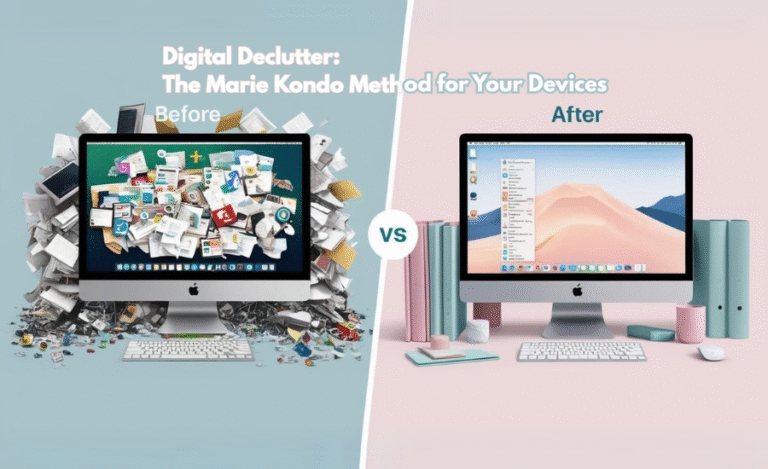
Do you ever feel a phantom vibration in your pocket, only to find no new notification? Ready to reclaim your focus and find calm in a noisy world? Take our two-week challenge, a guided digital detox for mental health. This simple plan is designed to help you reduce screen time, lower anxiety, and improve your sleep, leading to a more present and balanced you.
Do you unlock your phone to check the weather and surface 20 minutes later from a social media black hole, with no memory of how you got there? You pick it up an average of 96 times a day—once every 10 minutes—and for what? A hit of anxiety, a dose of comparison, and a fractured attention span.
If you feel like your phone owns you more than you own it, you’re in the right place. This isn’t just another article about screen time; this is a concrete plan. Welcome to the Two-Week Phone Reset Challenge, your guided journey to transform your digital life and reclaim your most valuable resources: your time and your focus.
Over the next 14 days, you will systematically dismantle the compulsive habits your phone has built within you and replace them with intentional, powerful, and sustainable new ones. This isn’t about throwing your phone away; it’s about turning it from a dopamine-dealing slot machine back into a powerful tool that serves your goals. Are you ready to stop being a scroll zombie and start being the master of your technology?

Why Your Brain is Hooked (Hint: It’s Not a Moral Failing)
Before we dive into the “how,” it’s crucial to understand the “why.” If you feel powerless against the pull of your phone, it’s because it was designed that way. Your struggle isn’t a lack of willpower; it’s a battle against an army of neuroscientists and behavioral psychologists whose job is to keep you hooked.
This dynamic is rooted in a simple brain chemical: dopamine. Tech platforms have perfected the art of the “variable reward loop,” the same mechanism that makes slot machines so addictive. When you pull your screen down to refresh your feed, you don’t know what you’ll get.
Will it be a “like” on your photo? A juicy news headline? A boring ad? This unpredictability releases a small hit of dopamine, creating a craving to check again… and again. The red notification bubbles, the “streaks,” the infinite scroll—these are not features; they are meticulously crafted tools of attention capture.
Conceptual Quote: “We are wiring our brains for distraction. Every notification, every buzz, every ping trains us to abandon deep focus in favor of shallow, urgent stimuli. The first step in reclaiming your mind is to cut the wires.” – Fictional Neuroscientist Dr. Alistair Finch
Understanding this is liberating. It reframes the problem from “I have no self-control” to “I am using a tool that is designed to undermine my self-control.” The Two-Week Phone Reset Challenge is your way of fighting back, of rewiring your brain’s responses and taking back the reins from the algorithms.
The Philosophy of the Reset: Digital Minimalism, Not Digital Abstinence
Let’s be clear about one thing: the goal here is not to become a tech-hating hermit. Your phone is a phenomenal tool for connection, knowledge, and utility. The problem arises when the tool starts using the user. This challenge is rooted in the philosophy of digital minimalism, a term popularized by author Cal Newport.
Think of it like this: Imagine your phone is a room. Right now, that room is likely cluttered with junk you never use, filled with noisy gadgets that are always demanding your attention, and has a revolving door for anyone to walk in unannounced. It’s chaotic and stressful.
The goal of this challenge is not to burn the room down. The goal is to declutter it. We will spend two weeks taking everything out of the room. Then, we will very carefully, very intentionally, decide what to put back in. Each item—each app, each notification setting, each habit—must earn its place by providing immense value.
The result isn’t an empty room; it’s a clean, functional, and peaceful space where you are in complete control. It’s a workshop, not a casino. This distinction is the key to long-term success.
Preparing for Liftoff: Your Pre-Challenge Checklist
Success in this challenge hinges on preparation. You wouldn’t run a marathon without training, and you shouldn’t start this reset on a whim. Take a day or two to complete the following steps to set yourself up for a profound transformation.
- State Your “Why”: Grab a notebook. Write down exactly why you are doing this. Do you want to be more present with your kids? Finish that book you started? Reduce your anxiety? Be specific and emotional. When things get tough, this “why” will be your anchor.
- Benchmark Your Usage: You can’t improve what you don’t measure. Use your phone’s built-in screen time utility (or download a third-party app like Moment or StayFree) to get a baseline. Note your daily average screen time and your most-used apps. This data will be shocking, and that’s the point.
- Inform Your People: Let your family, close friends, and maybe even your boss know that you’re starting a phone reset. Explain that you’ll be less responsive to non-urgent messages and might miss things on social media. This manages expectations and prevents you from feeling guilty or pressured.
- Buy an Alarm Clock: If you use your phone as an alarm clock, this is your first and most important change. The bedroom should be a sanctuary, and bringing your phone to bed with you is like inviting a thousand screaming people into it. Buy a cheap, simple, digital alarm clock. Today.
- Plan Your Analogue Alternatives: What will you do with all your newfound time? Make a list of non-digital activities you enjoy: reading a physical book, going for a walk, listening to music on a dedicated device, journaling, drawing, or cooking. Have these ready to go so you can replace the scrolling habit with a fulfilling one.
Your Guide to the Two-Week Phone Reset Challenge: A Day-by-Day Breakdown
Here it is. The roadmap for the next 14 days. Follow it closely. Don’t skip steps. Trust the process.
Week 1: The Great Digital Declutter
The goal of this week is to strip your phone down to its bare essentials, breaking the automated cycles of compulsive checking.
- Day 1: The Notification Nuke. Go into your settings and turn off all notifications, except for phone calls and messages from specific, crucial contacts (e.g., your partner, your kids’ school). No banners, no sounds, no red bubbles. You now check your phone on your schedule, not when it beckons.
- Day 2: Go Grayscale. This is a game-changer. Turning your screen to grayscale removes the psychologically stimulating, colorful icons that trigger dopamine hits. The world inside your phone suddenly becomes less appealing than the vibrant world outside.
- Day 3: The App Purge. Delete every single app you haven’t used in the last month. Be ruthless. For social media apps, gaming apps, and news apps—delete them all. Yes, all of them. You can access them via a web browser if absolutely necessary, which adds a crucial layer of friction.
- Day 4: The Home Screen Scrub. Your home screen should be a toolbox, not a Times Square billboard. Remove every app from your home screen except for 3-5 pure utility tools (e.g., maps, camera, calendar, notes). Move everything else into a single folder on the second page.
- Day 5: Establish No-Phone Zones & Times. Formally declare certain spaces and times as 100% screen-free. The classic examples are the dinner table, the bedroom, and the first hour of your day.
- Day 6: Unfollow & Unsubscribe. Go to your email and unsubscribe from every single promotional newsletter. Then, if you must check social media via a browser, spend 15 minutes unfollowing accounts that make you feel inadequate, angry, or anxious.
- Day 7: Reflect and Read. Look at your screen time report. Compare it to your benchmark. How do you feel? Journal about the experience. Use the time you would have spent scrolling to read a long-form article or a chapter of a book.
Week 2: Intentional Reintegration
Now that you’ve broken the addiction, this week is about thoughtfully rebuilding your relationship with technology on your own terms.
- Day 8: Define Your Phone’s “Job Description.” What is this tool for? Write down 3-5 core functions (e.g., “Connecting with my 5 closest friends,” “Navigating to new places,” “Capturing memories of my children”). Any app or habit that doesn’t serve this job description is a candidate for elimination.
- Day 9: The Slow App Return. You can now reinstall one or two apps that you genuinely missed and that serve your phone’s job description. As you reinstall one, ask yourself: “How will I use this app intentionally?”
- Day 10: Schedule Your Scrolls. If you choose to reinstall a social or news app, do not allow yourself to check it randomly. Designate a specific time and duration (e.g., “15 minutes at 7 PM”) to use it. Set a timer and stick to it.
- Day 11: Batch Your Communications. Instead of responding to texts and emails as they arrive, designate 2-3 “communication blocks” per day to process them all at once. This protects your deep focus time.
- Day 12: Practice Single-Tasking. Use your phone for one thing at a time. If you’re looking up a recipe, don’t also check your email. If you’re listening to a podcast, don’t also browse the web. Do one thing, then put the phone down.
- Day 13: Curate Your Content. Re-subscribe to a small handful of high-quality newsletters that you love. Follow creators who inspire and educate you. Transform your phone from a source of junk food into a curated library.
- Day 14: Create Your “Personal User Manual.” Based on the last 13 days, write a new set of rules for your phone usage. This is your personal policy document for a healthy digital life. For example: “No phone in the bedroom,” “Social media only on weekends,” “Delete email app from phone.”
Life After the Challenge: Making Your New Habits Stick
Congratulations! You’ve completed the Two-Week Phone Reset Challenge. The world should feel different—colors brighter, your thoughts clearer, your relationships richer. But the work isn’t over. The algorithms are always waiting to pull you back in.
To maintain your hard-won freedom, you must build a system of defense.
Key Maintenance Strategies:
- Schedule a Quarterly Audit: Every three months, repeat a mini-version of Week 1. Prune your apps, clean your home screen, and check your notification settings.
- Keep Your “Why” Visible: Post the “why” you wrote down on Day 1 somewhere you can see it every day, like your bathroom mirror or desk.
- Embrace JOMO (The Joy of Missing Out): Reframe your mindset. Find joy in being disconnected. Relish the fact that you don’t know the latest outrage or meme. Your peace is more valuable than their engagement.
- Be a Digital Role Model: Your new habits will inspire others. Talk about your experience and the benefits you’ve seen. Your journey can be the catalyst for change in your family and community.
Frequently Asked Questions
What if I fail or miss a day of the Two-Week Phone Reset Challenge?
Do not treat it as a failure. This is a practice, not a test. If you slip up, simply acknowledge it without judgment and get back on track the next day. The goal is not perfection; it’s intention and awareness. Each time you notice you’ve fallen into an old habit, you’ve strengthened your ability to recognize it in the future.
Is the Two-Week Phone Reset Challenge realistic if I need my phone for work?
Absolutely. This challenge is about eliminating unintentional and compulsive use, not essential use. By batching your communications (Day 11) and removing distracting apps (Day 3), you will likely become more productive and focused during your work hours, not less. The key is to clearly define what “work use” is and stick to it.
What are the biggest benefits people experience after the Two-Week Phone Reset Challenge?
While it varies, the most commonly reported benefits are a dramatic decrease in anxiety, a significantly improved ability to focus on complex tasks (deep work), being more present and engaged with loved ones, better sleep quality (from banning the phone from the bedroom), and a rediscovery of offline hobbies and joys.






